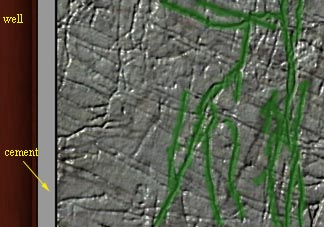Carbonates are not a drink
Posted by Heading Out on September 3, 2005 - 3:51pm
For those here last week, when we talked about sandstone and permeability I commented that the carbonate deposits are somewhat different to the sandstone ones. For a start the rock itself is much finer grained than a typical sandstone. Even if there were oil in the body of the rock it would be difficult to get out. Most of the oil is found in what I called secondary porosity. This is the network of fractures and bedding planes that are formed in the rock as it is compressed and moved after it has first been formed. The rock is largely limestone, though it may also be dolomite or related rocks. The rock is usually not a massive, solid rock (such as you might want to build a house or cathedral with).
Rather oil will collect where there are spaces in the rock. These can be where there was a coral reef, or a lot of change in rock structure. You can see that sort of thing in some new road cuts such as this one.
. It is easier to explain some of the problems of getting the oil out, if one looks at a roadcut that has weathered a bit .
You can see how the passage of water has opened the joints and dissolved small holes (or vugs) in the rock. These provide the spaces in the rock into which the oil can move and collect and be trapped. Perhaps it might be easier if I used a simpler sketch of a section through the rock to make the next point.  With the oil painted green, as it fills one crack system, but not them all, the well is just a little bit too far to the left to tap into the major fissure system and get all the oil. If only we could reach out a few feet and hit those cracks! And we can and do..
With the oil painted green, as it fills one crack system, but not them all, the well is just a little bit too far to the left to tap into the major fissure system and get all the oil. If only we could reach out a few feet and hit those cracks! And we can and do..
This is part of the reason that we send down small explosive charges that not only penetrate through the well case and the concrete, but also extend a hole out into the rock. By driving these perforations out into the crack system in the rock a path can be created from the oil-filled cracks to the well. Those cracks can also be cleaned up a bit (since they often have very small particles of carbonate filling them in the zone around the well) by having an acid pumped down into the completion zone. This acid will also open up some of the finer fissures in the rock so that a free path will develop from the well to the oil-filled cracks.
And so we can begin to produce oil. However after a while, for one of several reasons, the flow from the well will begin to decline. I mentioned last time that the underlying reason will be that the pressure in the reservoir will drop as the oil is withdrawn. But there are other reasons.
If the oil is removed too quickly we can generate, before we need to, a gas cap in the well. Fine rock can be carried through the cracks towards the well, and block the passages. Some of the oil contents, such as the waxes, can settle out of the oil, and fill the holes in the well casing. As the oil flows to the well, underlying water can follow it and cut-off blocks of oil in the rock. And the pressure difference between the oil further away from the well, and the well itself might not be enough to move that more distant oil towards the well. (Are you really sure you want to make this investment ?)
In the last case the historic answer was to drill more wells, stepped-out from the original well. These secondary wells offer a better chance of finding oil than the original wildcat since we already know that there is some oil here worth getting. The question now is to decide how far, and in which direction we need to go to drill our next development well. This is where we need to bring in some more expert advice, and it is why we also need to log the well. This involves making a map, using a variety of tools, of the rock that has been drilled through, and its properties, so that an educated guess (A SWAG rather than a WAG) can be made as to where to go next. Today we also have other options.
From which you will see that there is still lots to talk about. But, as before, if I have glossed over stuff, just ask a question and I (or others who contribute) will be glad to give an answer.
Previous posts include:
the drill
using mud
the derrick
the casing
pressure control
completing the well
flow to the well




This is some science and still a lot of art, and a greater chunk of luck, though the science is getting better.
the odds that a windfarm will be putting out btus in duetime are pretty high. What are the odds on wildcat holes?
Tom:
It really depends on where you are and how much background information you have - for e.g Saudi Arabia or Oklahoma, and how good the surveys have been but it varies between 1 in 5 and 1 in 15 (though I would ask that those who might have a better set of numbers to correct me, or refine these odds).